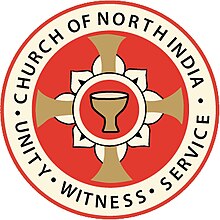
Back Church of North India German Eklezio de Norda Barato Esperanto उत्तर भारत का गिरजाघर Hindi Chiesa dell'India del Nord Italian 北インド教会 Japanese 북인도 교회 Korean Igreja do Norte da Índia Portuguese Церковь Северной Индии Russian Church of North India SIMPLE
| Church of North India | |
|---|---|
 Official seal of the Church of North India | |
| Classification | Protestant |
| Orientation | United church |
| Polity | Episcopal[1][2] |
| Moderator | The Most. Revd. Bijay Kumar Nayak |
| Deputy moderator | The Rt. Revd. Paul B.P. Duphare |
| Distinct fellowships | World Council of Churches, Council for World Mission, Christian Conference of Asia, Communion of Churches in India, National Council of Churches in India |
| Associations | |
| Region | All of India except Andhra Pradesh, Telangana, Lakshadweep, Karnataka, Kerala and Tamil Nadu |
| Origin | 29 November 1970 Nagpur |
| Merger of |
|
| Separations | United Church of Northern India – Presbyterian Synod[3] |
| Congregations | 3500 congregations in 3000 parishes and 26 dioceses[4] |
| Members | 2,200,000 (Self-declared)[4] |
| Ministers | 2000+[4] |
| Hospitals | 65 hospitals and nine nursing schools. |
| Secondary schools | 564+ educational institutions and three technical schools. |
| Official website | cnisynod.org |
The Church of North India (CNI) is the dominant united Protestant church in northern India. It was established on 29 November 1970 by bringing together most of the Protestant churches working in northern India. It is a province of the worldwide Anglican Communion and a member of the World Methodist Council and the World Communion of Reformed Churches.[5][4] The merger, which had been in discussions since 1929, came eventually between the Church of India, Pakistan, Burma and Ceylon (Anglican), the Methodist Church, Disciples of Christ, and some congregations from the United Church of Northern India (Congregationalist and Presbyterian).[5]
The CNI's jurisdiction covers all states of India with the exception of the five states in the south (Andhra Pradesh, Telangana, Karnataka, Kerala and Tamil Nadu which are under the jurisdiction of the Church of South India) and has approximately 2,200,000 members (0.1% of India's population) in 3,000 pastorates.[3]
- ^ IDOC International. IDOC-North America. 1971. p. 85.
...churches that would combine the episcopal, presbyterian and congregational forms of church polity, and would accept the historic episcopate without committing the church to any particular theological interpretation of episcopacy. This is essentially what has been done both in the Church of South India and the Church of North India.
- ^ Campbell, Ted (1996). Christian Confessions: A Historical Introduction. Westminster John Knox Press. p. 173. ISBN 978-0-664-25650-0.
The Church of South India (1947) and the Church of North India (1970) are unique and ecumenically important because they have combined the "historic episcopate" with other forms of polity
- ^ a b "United Church of Northern India - Presbyterian Synod". Address data base of Reformed churches and institutions. Stiftung Johannes a Lasco Bibliothek Grosse Kirche Emden. 2020. Retrieved 4 July 2019.
- ^ a b c d "Church of North India". World Council of Churches. n.d. Retrieved 4 July 2019.
- ^ a b "Church of North India". World Methodist Council. 9 November 2019. Retrieved 25 June 2020.
The Church of North India is a united church which came into being as the result of a union of six churches on 29th November 1970. The six churches were: The Council of the Baptist Churches in Northern India, The Church of the Brethren in India; The Disciples of Christ; The Church of India (formerly known as the Church of India, Pakistan, Burma and Ceylon); The Methodist Church (British and Australian Conferences); The United Church of Northern India. ... The Church of North India is a full member of the World Council of Churches, the Christian Conference of Asia, the Council for World Mission, the Anglican Consultative Council, the World Methodist Council and the World Alliance of Reformed Churches.
© MMXXIII Rich X Search. We shall prevail. All rights reserved. Rich X Search